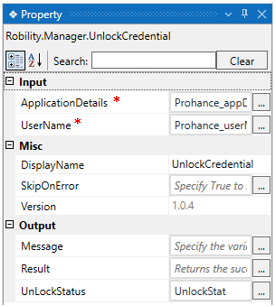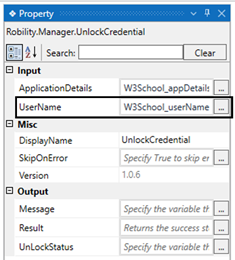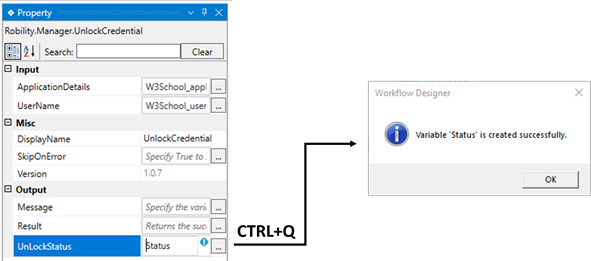This activity helps in unlocking a credential that has been locked in the
“RobilityManager.” We can either unlock the application directly in manager or use
this activity to unlock the same, during the workflow execution.
This activity functions independently or can be used along with the “GetCredentials”
activity.
Technical Reference
|
INPUT |
ApplicationDetails: Specify the variable in which the input has been stored.
This parameter helps you to “unlock” the credentials using the “ApplicationDetails”.
The input must be a “JsonString” which consists of the concatenated “Application details”.(Refer Tips).
This field accepts only “String” datatype. |
|
|
Username: Specify the “Username” or provide the variable in which the input username has been stored.
This parameter helps you to “unlock” the credentials using the “Username”.
This field accepts only “String” datatype. |
||
|
MISC |
DisplayName: Displays the name of the activity. It can also be customized to help in troubleshooting. |
|
|
SkipOnError: It specifies whether to continue executing the workflow even if it throws an error. This supports only Boolean value “True or False”. By default, it is set to “False.” True: Continues the workflow to the next step None: If the option is specified as blank, by default the activity will perform as “False” action. |
||
|
Version: It specifies the version of the Robility Manager feature in use |
||
|
OUTPUT |
Message: It helps to view the output of activity in a “String” datatype in case an error occurs during the process of unlocking the credential. |
|
|
Result: It helps to view the execution state of the activity. It returns the values in Boolean format. True: It indicates the activity has been executed successfully without any error. False: It indicates that the activity has been faulted due to some unexceptional error thrown. |
||
|
Status: This facilitates to provide the output of the “Unlock” status in a “Boolean” datatype. Success: It indicates that the “Credential” has been unlocked successfully. Failure: It indicates that the “Credential” has not unlocked due to some unexceptional error thrown. The error message can be viewed in the “Message” field in the output if a variable has been declared. |
* Represents mandatory fields to execute the workflow
Here is an example of how the “UnlockCredential” activity works –
In the following example, I'm using the “Credentials” that has been created and used
in the use case. To get more detailed information, click here.
1. Drag and drop the “UnlockCredential” activity from the “Manager” feature.
a. It helps to “unlock” the credentials which has been locked in the “RobilityManager”
during the execution of the bot.
b. Here I am going to “Unlock” the application which has been locked during the
execution of the bot.
i. “W3School” is the application name that is in locked state.
c. Double clicking on the activity to provide the “ApplicationDetails”.
i. In this case, I’m using the “W3School_appDetails_1” variable which has been
declared as output in the “GetCredentials” activity. (Refer the use case).
d. Navigating to the “Username” in the properties of the “UnlockCredential” activity.
i. This parameter helps you to unlock the credentials using the “Username” from
the “Credential Vault”.
ii. Here I am using the “Username” as “W3School_userName” which has been
declared as output in the “GetCredentials” activity.(Refer use case)
e. Moving to the “UnlockStatus” in the output properties to declare a variable
to check whether the “Credentials” has been unlocked.
i. There are two ways to declare a variable-
ii. Method 1 – Click on the "UnLockStatus" property within the "UnlockCredential"
activity and enter the variable name. In this case, we are using " Status." Then,
press "Ctrl+Q," which is a shortcut key to create a variable.
iii. Method 2 - Click on the Variables pane and enter the name " Status." Then,
in the "Variable Types" column, select "String" from the dropdown menu.
2. Now, I have executed the workflow to “Unlock” the credentials.
Click here to know how the activity is used in the workflow.






